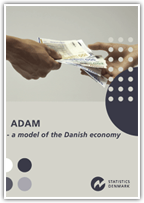Multiplier analysis
As part of testing and analysing the model a set of standard multipliers, first year effects and a collection of examples is presented with every model version. These give a broad overview of the analysis possibilities of ADAM. Multipliers are used to analyse the effects of economic and political changes. A demand shock in ADAM affects both production, employment and consumption in the short run. In the long run the effect on employment disappears. In contrast, a supply shock will have a permanent effect on employment. This is in line with most models of small open economies with a fixed exchange rate policy and a Phillips curve.
In principle, there is no automatic monetary or fiscal policy reaction function in ADAM. This aspect should be taken into consideration in the comparison with other economic models. Furthermore the specific danish laws and rules modelled in ADAM could be important when comparing with models for other economies.
For every new model version a series of standard experiments are produced to enable the analysis of the model characteristics. At the same time, the experiments makes it possible to compare the characteristics of the new model version with previous ones. All multiplier analysis are based on a base line representing a solution with respect to the endogenous variables based on a stylized forecast of the exogenous variables.
standard multipliers are made by changing one or a few of the exogenous variables and afterward calculating the effect on the endogenous variables.
first year effects represents the short run. Focus is especially on fiscal policy and the characteristics are examined by comparing with the previous model version.

